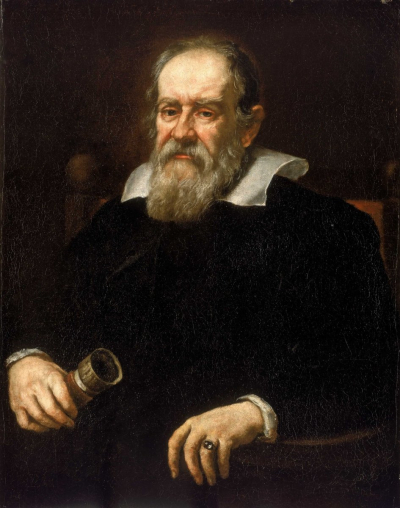The Galilean moons (), or Galilean satellites, are the four largest moons of Jupiter: Io, Europa, Ganymede, and Callisto. They were first seen by Galileo Galilei in December 1609 or January 1610, and recognized by him as satellites of Jupiter in March 1610. They were the first objects found to orbit a planet other than the Earth.
They are among the largest objects in the Solar System with the exception of the Sun and the eight planets, with a radius larger than any of the dwarf planets. Ganymede is the largest moon in the Solar System, and is even bigger than the planet Mercury, though only around half as massive. The three inner moonsIo, Europa, and Ganymedeare in a 4:2:1 orbital resonance with each other. While the Galilean moons are spherical, all of Jupiter's much smaller remaining moons have irregular forms because of their weaker self-gravitation.
The Galilean moons were observed in either 1609 or 1610 when Galileo made improvements to his telescope, which enabled him to observe celestial bodies more distinctly than ever. Galileo's observations showed the importance of the telescope as a tool for astronomers by proving that there were objects in space that cannot be seen by the naked eye. The discovery of celestial bodies orbiting something other than Earth dealt a serious blow to the then-accepted Ptolemaic world system, a geocentric theory in which everything orbits around Earth.
Galileo initially named his discovery the Cosmica Sidera ("Cosimo's stars"), but the names that eventually prevailed were chosen by Simon Marius. Marius discovered the moons independently at nearly the same time as Galileo, 8 January 1610, and gave them their present names, derived from the lovers of Zeus, which were suggested by Johannes Kepler, in his Mundus Jovialis, published in 1614.The four Galilean moons were the only known moons of Jupiter until the discovery of Amalthea in 1892.
Galileo di Vincenzo Bonaiuti de' Galilei ( GAL-il-AY-oh GAL-il-AY-ee, -EE-oh -, Italian: [ɡaliˈlɛːo ɡaliˈlɛi]; 15 February 1564 – 8 January 1642), commonly referred to as Galileo, was an Italian astronomer, physicist and engineer, sometimes described as a polymath, from the city of Pisa, then part of the Duchy of Florence. Galileo has been called the "father" of observational astronomy, modern physics, the scientific method, and modern science.Galileo studied speed and velocity, gravity and free fall, the principle of relativity, inertia, projectile motion and also worked in applied science and technology, describing the properties of pendulums and "hydrostatic balances". He invented the thermoscope and various military compasses, and used the telescope for scientific observations of celestial objects. His contributions to observational astronomy include telescopic confirmation of the phases of Venus, observation of the four largest satellites of Jupiter, observation of Saturn's rings, and analysis of lunar craters and sunspots.
Galileo's championing of Copernican heliocentrism (Earth rotating daily and revolving around the sun) was met with opposition from within the Catholic Church and from some astronomers. The matter was investigated by the Roman Inquisition in 1615, which concluded that heliocentrism was foolish, absurd, and heretical since it contradicted Holy Scripture.Galileo later defended his views in Dialogue Concerning the Two Chief World Systems (1632), which appeared to attack Pope Urban VIII and thus alienated both the Pope and the Jesuits, who had both supported Galileo up until this point. He was tried by the Inquisition, found "vehemently suspect of heresy", and forced to recant. He spent the rest of his life under house arrest. During this time, he wrote Two New Sciences (1638), primarily concerning kinematics and the strength of materials, summarizing work he had done around forty years earlier.

1610Jan, 7
Galileo Galilei makes his first observation of the four Galilean moons: Ganymede, Callisto, Io and Europa, although he is not able to distinguish the last two until the following day.
Choose Another Date
Events on 1610
- 7Jan
Galilean moons
Galileo Galilei makes his first observation of the four Galilean moons: Ganymede, Callisto, Io and Europa, although he is not able to distinguish the last two until the following day. - 2Aug
Northwest Passage
During Henry Hudson's search for the Northwest Passage, he sails into what is now known as Hudson Bay. - 9Aug
Colony of Virginia
The First Anglo-Powhatan War begins in colonial Virginia.

 English
English  español
español  français
français  português
português  русский
русский  العربية
العربية  简体中文
简体中文 